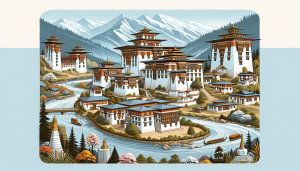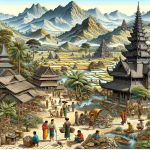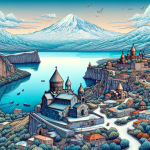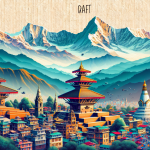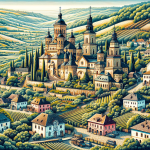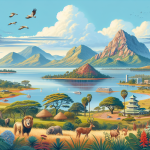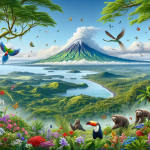Bhutan: The Last Shangri-La of the Himalayas
Nestled in the heart of the Eastern Himalayas, Bhutan, often referred to as the “Last Shangri-La,” is an enchanting kingdom that offers a unique blend of ancient traditions and modern sensibilities. Renowned for its stunning landscapes, rich cultural heritage, and the philosophy of Gross National Happiness (GNH), Bhutan remains a coveted travel destination for those seeking both adventure and spiritual enrichment. This small, landlocked country, bordered by India and China, has managed to preserve its natural beauty and cultural identity, making it a dream destination for eco-tourists, trekkers, and cultural enthusiasts alike. In this comprehensive guide, we will delve into the myriad facets of Bhutan, exploring its breathtaking landscapes, vibrant festivals, and the unique experiences it offers to travelers. Whether you are planning your first trip or returning to discover more, this article will provide you with the essential information and inspiration you need to make the most of your Bhutanese adventure.
The Rich Cultural Heritage of Bhutan
Bhutan’s cultural heritage is deeply rooted in its Buddhist traditions, which permeate every aspect of daily life. The nation boasts numerous monasteries, temples, and dzongs (fortresses) that stand as testaments to its spiritual and historical legacy.
Dzongs: The Fortresses of Bhutan
Dzongs are architectural marvels that serve multiple purposes, including administrative centers, monastic complexes, and fortresses. Paro Dzong and Punakha Dzong are among the most famous. Paro Dzong, also known as Rinpung Dzong, offers stunning views and houses a famous religious festival, the Paro Tshechu, held annually in spring. Punakha Dzong, located at the confluence of the Pho Chhu and Mo Chhu rivers, is renowned for its intricate woodwork and beautiful setting.
Monasteries and Temples
Bhutan is home to some of the world’s most beautiful and secluded monasteries. Tiger’s Nest Monastery, or Taktsang Monastery, is perhaps the most iconic. Perched precariously on a cliff 900 meters above the Paro Valley, it is a sacred pilgrimage site that offers both spiritual solace and breathtaking views. The Kyichu Lhakhang in Paro is one of the oldest temples in Bhutan, believed to have been built in the 7th century.
Festivals and Traditions
Bhutanese festivals, known as Tshechus, are vibrant, colorful events that provide a deep insight into the country’s cultural and religious life. These festivals feature traditional dances, music, and rituals, and are usually held in the courtyards of dzongs and monasteries.
Paro Tshechu
One of the most popular festivals is the Paro Tshechu, which attracts thousands of locals and tourists. The highlight of the festival is the unveiling of a giant thangka (embroidered painting) depicting Guru Rinpoche, which is believed to bless all who view it.
Thimphu Tshechu
Another significant festival is the Thimphu Tshechu, held in the capital city. This festival features masked dances, known as Cham, which are performed by monks and laymen. The dances are not only entertaining but also carry deep religious significance, believed to bring blessings and ward off evil spirits.
Natural Beauty and Outdoor Activities
Bhutan’s diverse landscapes, ranging from subtropical plains to alpine mountains, offer a plethora of outdoor activities for adventure enthusiasts.
Trekking in Bhutan
Trekking is one of the most popular activities in Bhutan, with trails that cater to all levels of experience. The Jomolhari Trek is one of the most famous, offering stunning views of Mount Jomolhari and the opportunity to explore remote villages and monasteries. The Snowman Trek is considered one of the most challenging treks in the world, taking you through some of Bhutan’s most isolated regions.
Bird Watching and Wildlife
Bhutan is a paradise for bird watchers and wildlife enthusiasts. The country is home to over 770 species of birds and numerous endangered animals, including the elusive snow leopard and the Bengal tiger. The Phobjikha Valley is a significant wintering ground for the black-necked crane, and a visit to the Gangtey Monastery offers a chance to see these majestic birds.
Sustainable Tourism in Bhutan
Bhutan is committed to sustainable tourism, guided by the principles of Gross National Happiness. The government imposes a minimum daily tariff for tourists, which includes accommodation, meals, and a licensed guide. This policy aims to preserve the country’s cultural heritage and natural environment while providing a high-quality experience for visitors.
Gross National Happiness
The concept of Gross National Happiness (GNH), introduced by the Fourth King of Bhutan, is a guiding philosophy that prioritizes the well-being of citizens over economic growth. GNH encompasses sustainable development, cultural preservation, environmental conservation, and good governance.
Environmental Conservation
Bhutan is a global leader in environmental conservation, with over 70% of its land area covered in forests. The country has committed to remaining carbon neutral and has implemented numerous initiatives to protect its natural resources. National parks and wildlife sanctuaries, such as the Jigme Dorji National Park and the Royal Manas National Park, offer opportunities for eco-tourism and wildlife viewing.
Practical Information for Travelers
Visa and Permits
All tourists (except citizens of India, Bangladesh, and the Maldives) require a visa to enter Bhutan. Visas must be arranged through a licensed Bhutanese tour operator or an international partner. A daily tariff, which covers accommodation, meals, transportation, and a licensed guide, is also mandatory.
Best Time to Visit
The best time to visit Bhutan is during the spring (March to May) and autumn (September to November) when the weather is pleasant, and the skies are clear. These seasons are also ideal for trekking and attending festivals.
Accommodation
Bhutan offers a range of accommodation options, from luxury hotels to traditional guesthouses. Many hotels are designed in traditional Bhutanese style, providing a unique cultural experience. Some popular luxury hotels include Aman Resorts, COMO Uma, and Six Senses Bhutan.
Conclusion
Bhutan, with its rich cultural heritage, stunning landscapes, and commitment to sustainable tourism, offers a unique and enriching travel experience. Whether you are interested in exploring ancient monasteries, participating in vibrant festivals, trekking through pristine landscapes, or simply experiencing the Bhutanese way of life, this magical kingdom has something for everyone. As you plan your journey, remember to respect the local customs and traditions, and embrace the philosophy of Gross National Happiness that makes Bhutan truly special. For more detailed information on planning your trip, you can visit Bhutan’s official tourism website.
